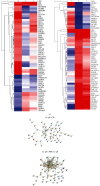Transcriptome Analysis of Platelet-Rich Plasma-Treated Osteoarthritic Chondrocyte
- PMID: 39610694
- PMCID: PMC11604281
- DOI: 10.1155/2024/7680736
Transcriptome Analysis of Platelet-Rich Plasma-Treated Osteoarthritic Chondrocyte
Abstract
As a blood-derived biomaterial, platelet-rich plasma (PRP) has been considered a potential therapy and tried in knee and hip osteoarthritis with beneficial effects as an anti-inflammatory and potent regenerative agent. To better understand the substantial effect of PRP on chondrocytes in an inflammatory environment, we analyzed the transcriptome profile by RNA sequencing (RNA-seq) after PRP administration in IL-1β-treated osteoarthritic chondrocytes which were isolated from human knee articular cartilage tissue. A total of 24,424 genes were analyzed, and significant changes in expression were observed for 226 genes in the control (CTL) versus IL-1β group and 300 genes in the IL-1β versus IL-1β+PRP group. The Top 20 significantly upregulated and downregulated genes and the major altered genes in nine categories that are closely related to chondrocyte physiology were analyzed, and the expression of several important genes in each category was evaluated by qRT-PCR and western blot analysis. Our study revealed that the PRP, at the gene expression level, has apparent anti-inflammatory, cell proliferative, and regenerative activities in chondrocytes in the presence of IL-1β, which mimic an osteoarthritic environment. Identifying potent molecules that regulate cartilage physiology represents a promising therapeutic approach for suppressing cartilage degeneration, especially that caused by inflammation-induced osteoarthritis.
Copyright © 2024 Dae Keun Suh et al.
Conflict of interest statement
The authors declare no conflicts of interest.
Figures






References
MeSH terms
Substances
LinkOut - more resources
Full Text Sources
Medical
Research Materials

